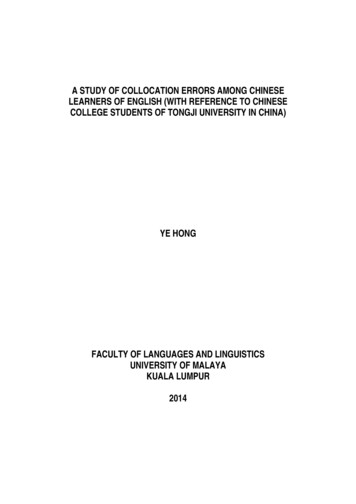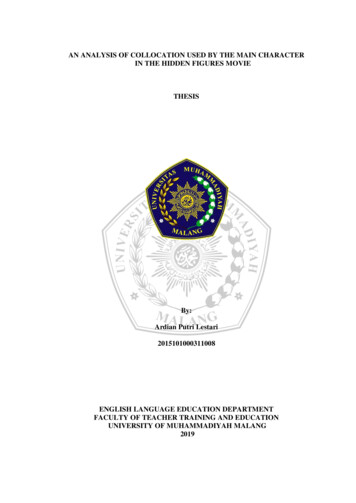
Transcription
Domain Collocation IdentificationJiří MaternaCentre for Natural Language ProcessingFaculty of Informatics, Masaryk UniversityBotanická 68a, 602 00, Brno, Czech stract. In this paper we present a new method of automatic collocationidentification. Collocation is an important relation between words, whichis widely used, among others, in information retrieval tasks. Over the lastyears, many methods of automatic collocation acquisition from text corporahave been proposed. The approach described in this paper differs from theothers in focusing on domain collocations. By the domain collocation wemean a collocation which is specific for a relatively small set of documentsrelated to the same topic. The proposed method has been implemented andused in a real information retrieval system. Comparing to the common nondomain approach, the precision of the system has increased significantly.Key words: collocation; domain; information retrieval1IntroductionLexical collocations are an important phenomenon in many natural languageprocessing tasks like computational lexicography [1], word sense disambiguation [2], machine translation [3], information extraction [4], etc. In this work wefocus on their exploitation in information retrieval. In our information retrievalsystem, there is a need for identifying collocations in queries in order to treatthem as single units.Let’s have a look at a simple query finanční úřad v Karlových Varech (tax officein Karlovy Vary). Combinatorially, there are many ways how to parse it but, inour point of view, the correct one is only (finanční úřad) v (Karlových Varech). Itmeans that the identified collocation (in this case finanční úřad and KarlovýchVarech) should not be split.Collocation is an expression consisting of two or more associated wordsor tokens. Unfortunately, there is no formal linguistic definition. For us, thecollocation is understood as an n-gram of tokens whose co-occurrence ina large text corpus is statistically outstanding. There are many statisticalmeasures usable to detect collocations in corpora. Most of them are basedon classical mathematical statistics (t-score, chi-square) or information theory(mutual information). All these methods are widely used and explored in manyapplications but they suffer from the following disadvantages:Petr Sojka, Aleš Horák (Eds.): Proceedings of Recent Advances in Slavonic Natural Language Processing,c Masaryk University, Brno 2009RASLAN 2009, pp. 17–21, 2009.
18Jiří Materna– The association scores are strongly influenced by the size of the corpus. Thus,the score values acquired from different corpora are not comparable andeven the maximum or minimum values of the score may be different.– The association scores are suitable for identifying global collocations butthey are not convenient for domain-specific collocations, which are relevantonly for a small set of documents related to the same topic.The presented paper deals mainly with the second problem and is structured asfollows. In the next section we will introduce the most commonly used statisticalmethods of collocation identification in text corpora. In Sectioni 3 we will focuson a new method of domain collocation acquisition. In this section we will alsodiscuss advantages and disadvantages of the proposed method.2Statistical Approaches to Collocation IdentificationOver the last years, many methods of automatic collocation acquisition fromlarge text corpora have been proposed. All association scores which are subjectsof this research use only word frequency characteristics. The simplicity and theease of use belong to the most important advantages of the statistical approach.In order to ensure maximum readability of the paper we will only considercollocations consisting of two tokens but the described methods are universal.In the rest of the paper the following notation will be used:– f (t) – number of occurrences of term t in the whole corpus;– f (t1 , t2 ) – number of co-occurrences of terms t1 , t2 (by the co-occurrence wemean that the tokens occur in the corpus directly one after another);– n – number of all tokens in the corpus.T-scoreThis measure uses classical statistic approach based on Student’s t-test [5]. Theassociation score is defined as:f ( t ) f ( t2 )T ( t1 , t2 ) f ( t1 , t2 ) 1 npf ( t1 , t2 )MI-scoreThis measure comes from information theory and corresponds to the quantity ofinformation given by the occurrence of one term about occurrences of anotherone. The mutual information association score is defined as:MI (t1 , t2 ) log2f ( t1 , t2 ) nf ( t1 ) f ( t2 )
Domain Collocation Identification19MI2 -scoreMutual information score is a useful measure but it is strongly influenced bythe frequency of tokens. To reduce this disadvantage same heuristics have beenproposed [6]. One of the most popular is MI2 -score:MI2 (t1 , t2 ) log2f ( t1 , t2 )2 nf ( t1 ) f ( t2 )Dice scoreDice score identifies pairs with a particularly high degree of lexical cohesion (i.e.those with nearly total association) [7]:D ( t1 , t2 ) 2 f ( t1 , t2 )t1 t2logDice scoreDice score gives a good association score but the problem is that the values areusually very small numbers. This is solved by the logDice score [8]:logD 14 log22 f ( t1 , t2 )t1 t2In many application we need an universal score, which corresponds to thedegree of collocability. In this work the score is called proximity and ranges from0 (absolutely independent terms) to 1 (perfect collocations). To get the proximityFig. 1. Proximity distributionfrom association scores described above, we need to transform the scores intointerval [0, 1]. The conversion is done by normalizing the scores by their maximalvalues. The proximity distribution in a Czech web corpus (200 billions of tokens)for two best-resulting association scores is shown in Figure 1.
203Jiří MaternaDomain CollocationsThe association scores described in the previous section have some advantages –computation of their values is very fast and simple, they satisfactorily reflectcollocation scores of global collocations, etc., but they also have at leastone disadvantage – they are not convenient for identifying domain-specificcollocations, which are relevant only for a small set of documents related to thesame topic. An example of the domain collocation is rozhodovací strom (decisiontree), which is a strong collocation in the computer science domain but hardly ingeneral.The idea behind the method of identifying domain collocations is thatdomain collocations should be generated from domain specific sub-corpora.Nevertheless, there are many problems: what domains should be used, howto divide the corpus into domain specific sub-corpora, how to detect domainspecific collocation, etc.Probably the best way how to solve these problems is to avoid them.The solution is based on using the association scores described above withredefinition of the f (t) function. Value of the f (t) function is in the domainapproach defined as number of occurrences of term t in all documents containingall constituents of the investigated potential collocation. In other words, for bigram(t1 , t2 ), value of the f (t1 ) function is computed as a number of occurrences of t1in all documents containing both t1 and t2 at arbitrary location and vice versa.This approach has following consequences:– Value of the f (t) function is different for different bigrams. This is the sourceof a high computational complexity.– Value of the domain proximity is always higher then value of the nondomain proximity for the same bigrams.– Comparing to the non-domain approach, in the domain approach theproximity of good collocations increases rapidly, whereas proximity of noncollocations increases slightly.Examples of proximity values for some bigrams from the corpus are shown inthe Figure 2.collocation typebigramjízdní řády (timetables)karlovy varya ale (and but)non-collocationzelené myšlenky (green ideas)rozhodovací strom (decision tree)domain collocationtřecí síla (frictional force)global 0.820Fig. 2. Examples of proximity values.
Domain Collocation Identification421ConclusionsOne of the disadvantages of common association scores is a fact that somedomain specific collocation cannot be identified. This work solves this problemby providing a new approach to computing term frequencies with regard todomain collocations. This method does not nearly affect scores of good generalcollocation and non-collocations but significantly improve proximity score indomain specific collocation. The proposed method has been tested and is beingused in a real information retrieval system.Acknowledgements This work has been partly supported by the Ministry ofEducation of CR within the Center of basic research LC536 and in the NationalResearch Programme II project 2C06009.References1. Kilgarriff, A., Rychlý, P., Smrž, P., Tugwell, D.: The Sketch Engine in PracticalLexicography: A Reader. (2008) 297–306.2. Yarowsky, D.: Word Sense Disambiguation. In: The Handbook of Natural LanguageProcessing, New York: Marcel Dekker (2000).3. Smadja, F., Hatzivassiloglou, V., McKeown, K.R.: Translating Collocations for BilingualLexicons: A Statistical Approach. Computational Linguistics (1996).4. Lin, D.: Using Collocation Statistics in Information Extraction. In: Proceedings of theSeventh Message Understanding Conference (MUC-7. (1998).5. Church, K.W., Gale, W.A.: Concordances for Parallel Text. In: Proceedings of the 7thAnnual Conference of the UW Center for the New OED and Text Research, Oxford,UK. (1991).6. Oakes, M.P.: Statistics for Corpus Linguistics. Edinburgh University Press, Edinburgh(1998).7. Dias, G., Guilloré, S., Lopes, J.: Language Independent Automatic Acquisition ofRigid Multiword Units from Unrestricted Text Corpora. In: Proceedings of TraitementAutomatique des Langues Naturelles (TALN), Cargèse, France. (1999).8. Rychlý, P.: A Lexicographer-Friendly Association Score. In: Recent Advances inSlavonic Natural Language Processing. (2008).
collocation type bigram non-domain proximity domain proximity global collocation jízdnírády (timetables) 0.952 0.992 karlovy vary 0.983 0.995 non-collocation a ale (and but) 0.295 0.319 zelené my lenky (green ideas) 0.278 0.286 domain collocation rozhodovací strom (decision tree) 0.363 0.684 trecí síla (frictional force) 0.441 0.820 Fig.2.










